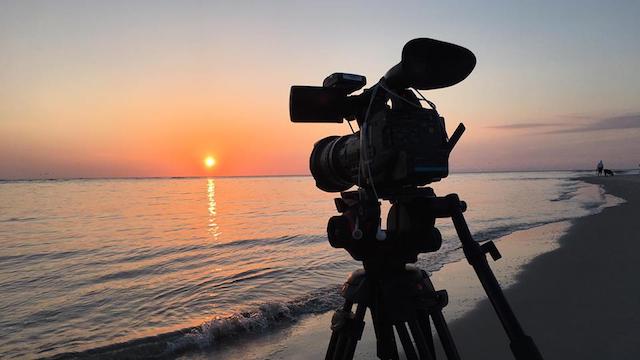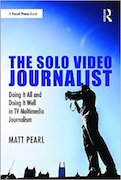Before November 8th, 2019, Paige Pauroso had begun to carve a modest reputation as a solo video journalist with little concern for limits.
At her first job in Lubbock she drove eight hours solo to cover an execution. Three months into her second job, at WBTV in Charlotte, she stood among 70-mile-per-hour winds on Myrtle Beach during Hurricane Dorian. Weeks before the November book, when a post in the Storytellers Facebook group asked for suggestions on strong hard news reporters, one commenter replied, “Paige at WBTV is amazing!”
“I used to joke at my old station that I didn’t sense fear,” Pauroso told me. “It didn’t cross my mind easily.”
Since November 8th?
“I think every local journalist in the country now knows me as the journalist who got whacked in the head.”
That day, Pauroso posted on Twitter and Facebook about what she had experienced a day earlier in the field. She had stopped along a busy block to shoot B-roll – “I just needed video of a street,” she says – when a woman approached her with foul language and demanded she stop recording. Pauroso tried to talk her down, and the woman eventually walked away. But as she collected her final shot, the woman returned, followed her, and smacked the back of her head with an open hand. The force pushed Pauroso’s head into her camera and left her with a bruise. The woman turned around and left. Pauroso got in her car and did the same.
When Pauroso made her experience public, journalists nationwide responded. Most expressed sympathy and solidarity. Others went further. They lamented the dangers of journalism in 2019. Many decried the entire concept of MMJs, vilifying it as a cost-saving maneuver for stations that puts its journalists in inherent danger. Pauroso, for her part, gave context to her solo status and praised her managers “who dropped everything to make sure I was OK and then let me lay low at work as I was still in shock this even happened.”
I, for one, don’t think the solo video journalist concept needs to be abolished – and wish that the same people who so quickly speak of its dangers would show the same concern for photographers who regularly get sent alone to press conferences, protests, and late-night crime scenes.
But I think our industry needs to treat MMJs with far more intentionality – and listen to the regular concerns we voice about our safety.
In early 2017, I conducted The MMJ Survey, a set of questions designed to get a better understanding of how solo video journalists view their jobs. I heard from 96 respondents, with diversity in age, gender, and market size.
And despite generally positive responses about their enjoyment of the job and ability to do it, I noticed a disturbing through-line when the questions dealt with safety.
More than 40% of respondents disagreed in some capacity with the statement, “I feel safe as an MMJ when in the field.” Female MMJs expressed safety concerns far more than their male counterparts, and virtually everyone expressed disgust for the concept of solo live shots, which have proliferated from small markets to Pauroso’s station and competition in Charlotte.
For these reasons and others, when I asked MMJs to rate their agreement with the statement, “I see myself as an MMJ ten years from now,” the majority disagreed.
To me, this says that our industry possesses this tremendous resource – versatile, flexible storytellers with the ambition and hustle to shoot, interview, report, and edit on their own – and does little to cultivate it. Plenty of soloists – myself included – work at stations that understand the model and have adjusted their newsroom workflow to better position their MMJs for success. Unfortunately, those stations often feel like the minority, and every station can do better in training its journalists on how to handle unsafe situations.
When we spoke about what happened, Pauroso made it clear why that’s not always enough.
“I’ve never been in a situation – in work, in life, in anything – where someone has hit me,” she said. “I’ve never been hit by anybody.”
She’s not alone. Few of us have been in meaningful fistfights, particularly while at work. And while we might think we know what to do if threatened, we might not follow through when it happens.
In Pauroso’s case, “I wasn’t recording when she hit me because I was so frazzled that it was happening that I wasn’t thinking of the thing your professors always tell you: ‘Always record, always record.’” Those professors at Elon University, Pauroso says, “were very frank about what this business was like. I knew what I was supposed to do, but until I really experienced it, I didn’t know what to do instinct-wise.
“Now I know, if this ever happens to me again, you need to be more prepared. Record the conversation. Walk away faster. Just leave.”
It’s difficult, but solo video journalists need to – every few weeks, perhaps – take the occasional minute in the field to cycle through how we would respond. We should visualize and confront it as best we can.
We also cannot hesitate to declare to our newsroom when we don’t feel safe.
Pauroso said her managers always made clear that she could turn down an assignment if she felt it was too dangerous. She never followed through.
“I used to think, ‘Oh, I’ll be fine. I’ll just walk away if someone’s mad.’ Now I think, ‘Well that’s maybe not always the way you can solve it.’”
While her assault didn’t occur in an inherently dangerous situation – it was on a busy street in the light of day – it has emboldened her to speak out since.
“Last night I didn’t go live,” she told me. “I didn’t want to go from this area that was highly known to be where drug deals happen. There had been a lot of shootings there. So I said, ‘I’m going to go live from the police station.’ And my producer didn’t blink once. She said, ‘Go ahead.’”
Too often, solo video journalists fear we’ll be judged for shying away from an assignment. After all, “solo” is in our job description, right? Why should we be surprised about getting assigned the kinds of stories that lead our newscasts every night? Won’t our managers secretly think we’re not willing to “do what it takes” to tell the best story?
But no story is worth it. I say this as someone who’s worked as an MMJ for nearly two decades and experienced virtually every side of it, including the threat of violence.
I was once sent to a small town in Georgia to look into accusations about its mayor, who was believed to have used taxpayer dollars to repave his driveway. As I gathered video, I was confronted by the mayor’s brother. I rolled on it covertly, keeping the camera at my right hip and never checking my shot, tried to keep the situation calm, and eventually retreated to my car. The resulting story – punctuated by the video of the confrontation – helped propel an investigation that led to the mayor’s ouster three months later. It even won an Emmy the following year for General News. But I still don’t know if I would do it again, knowing what I experienced.
And I hadn’t even been touched.
That said, I try to calculate the risks inherent in every decision I make as a soloist. I don’t send texts or e-mails while driving; I don’t risk my body to “get the shot”; and I don’t get out of my car if I don’t feel safe. I also follow stories like Pauroso’s to remain aware of the climate and context that can lead to encounters like hers.
Less than a month since she was assaulted doing her job, Pauroso seemed more than ready to move forward. But she knows exactly what she learned.
“You can’t go into situations blindly,” she says. “You can’t assume every situation is going to work out. It hasn’t made me more fearful. It has made me more aware. I’m not scared to do my job, but I am a little more on guard.
“And that is a good thing.”
The Solo Video Journalist is available for purchase. You can find it on Amazon, Barnes & Noble, and the publisher’s web site.
Matt Pearl is the author of the Telling the Story blog and podcast. Feel free to comment below or e-mail Matt at matt@tellingthestoryblog.com. You can also follow Matt on Facebook and Twitter.

